Eye Conditions

Age-Related Macular Degeneration
Learn More.
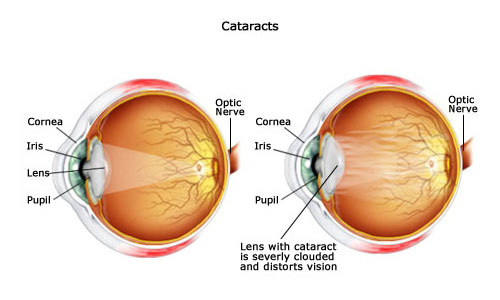
Cataracts
A cataract is a clouding of the eye’s lens. When we look at something, light rays travel through the pupil and are focused through the lens onto the retina. In order to focus light properly onto the retina, the lens must be clear. However, if the lens has become cloudy, it is called a cataract. If you start to notice that your vision has become blurry, dim or cloudy, and objects don’t seem as bright or colorful as they used to be, a cataract may have developed. People has said that it feels like they are looking through a dirty or cloudy car windshield. Cataract development is something that usually is very slow and not noticeable at first. Cataracts are one of the most common causes of vision loss, especially as we age because they are part of the normal aging process. They are treatable with cataract surgery, because there are no medications or eye drops that will make cataracts go away. If you have started to notice this cloudy vision, make an appointment with your eye doctor to discuss the possibility of a cataract.
Learn More.
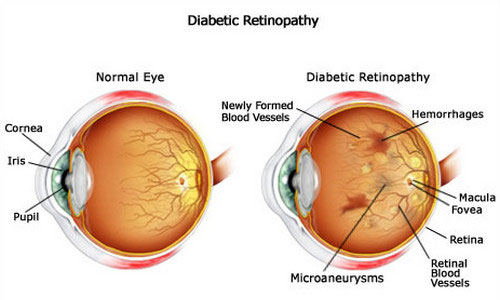
Diabetic Eye Disease
Diabetic eye disease, also known as diabetic retinopathy, is a common eye disease that progressively causes damage to the retina. The retina is the light sensitive lining at the back of the eye and when the tiny blood vessels that nourish the retina are damaged, diabetic retinopathy is the result. Diabetes can affect and damage a person’s eyes without them even knowing, because it usually does not cause any symptoms in its early stages. That is why our doctors recommend that if your have diabetes, you should have your eye examined and dilated every year. Those who suffer from diabetic eye disease may see spots or floaters, have blurred vision, have a dark or empty spot in the center of their vision, or have a difficulty seeing well at night. Treatment for diabetic retinopathy depends on the stage of the disease and the amount of vision that has been lost.
Learn More.
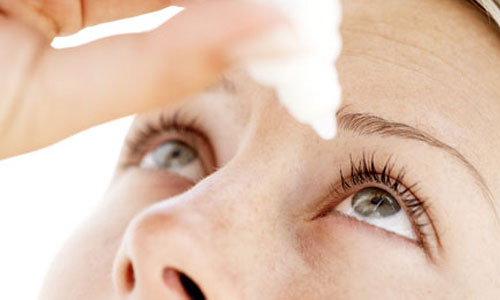
Dry Eyes
Dry eyes happens when there is a breakdown in the quantity or quality of tears to moisten and protect the eyes. Tears are made up of much more than just water. Tear are made from a rich complex mixture of water, fatty oils, minerals, proteins, and natural antibodies that nourish the surface of your eyes. This balanced mixture helps to keep your cornea smooth and clear, because without high-quality teats, having good vision is impossible. By producing tears at a slow and steady rate, the eye stays moist and comfortable. When experiencing dry eye, you may have symptoms such as burning, stinging, itching, pain, light sensitivity, redness, or blurry vision. Make an appointment with one of our doctors to help relieve you from these dry eye symptoms.
Learn More
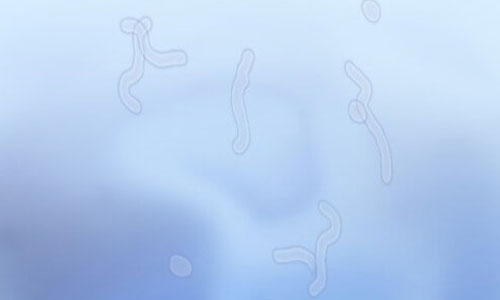
Floaters & Flashers
Have you been bothered by small specks, clouds, or flashing lights in your field of vision? If so, you may be suffering from “floaters” and “flashes”. It is not uncommon for people over 40 to have spots or specks appear in their vision from time to time. However, if you notice these floaters start becoming visible in every background, suddenly increase in number or are accompanied by any loss of vision, or you see flashes of light, it is very important that immediate medical advice is sought. This could be an early sign of a retinal tear or detachment. However, the treatment for floaters and flashes depends on the underlying condition. While not all floaters and flashes are serious, it may require an eye exam to determine the situation.
Learn More
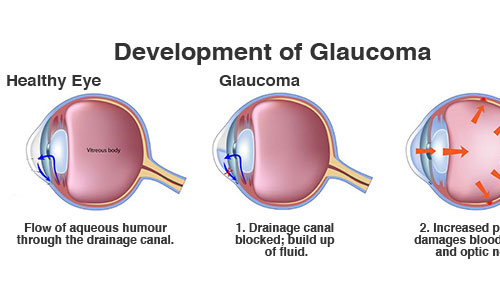
Glaucoma
Glaucoma is a disease that damages the eye’s optic nerve and can result in vision loss and blindness. It is the leading cause of blindness in the United States, especially among older patients. It happens usually when there is a build up of fluid in the front part of your eye. The extra build up of fluid then increases the pressure in your eye, therefore damaging the optic nerve. Think of your optic nerve like an electric cable containing over 1,500,000 “wires” or vision nerve fibers. A buildup of pressure within the eye from glaucoma can damage these delicate vision fibers, causing blind spots to develop. When glaucoma initially develops, usually you do not have any early symptoms or signs. It is a disease that progresses slowly, therefore your sight can be taken from you very gradually. Regular eye examinations by one of our doctors is the best way to detect glaucoma. With early detection and treatment, the good news is that you can often protect your eyes against serious vision loss.
Learn More
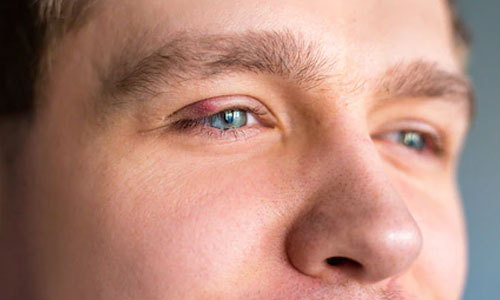
Stye
A stye is a red, small lump near the edge of the eyelid. Usually, styes are tender and a result from an infection of an blocked oil-producing gland. A stye can be classified into two distinct types: hordeolum and chalazion. In the early stages, a stye is called an internal hordeolum and it is a stye that occurs inside or under the eyelid. A chalazion forms when an oil-producing gland in the eyelid become swollen or enlarged and the gland becomes plugged with oil. Styes usually start as a red bump that looks like a pimple along the edge of the eyelid, but as it grows, you may notice that it has become swollen and/or painful. You eye may water and cause some irritation. Styes are not normally harmful to vision and generally heal within a few days. To help with the healing process, many people have found that warm, compresses 3 to 6 times a day can often help open up that blocked pore. That way the stye can drain and begin to heal. If the stye continues to bother you, feel free to call and schedule an appointment wtih one of our doctors.
Learn More
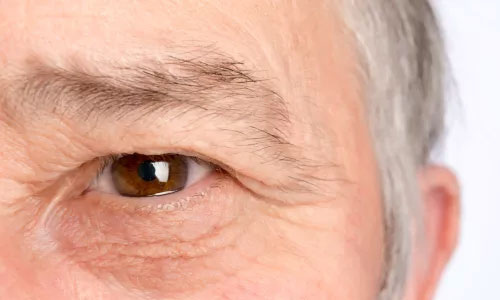
Droopy Lids
Brief Description: Droppy lids or ptosis referes to drooping of an upper eyelid of one or both eyes. Ptosis can affect both children and adults, but is more common in adults due to aging. Droopy lids may not cause a problem at first, but after a while, people may start to have difficult seeing. Ptosis can be present at birth, develop due to aging, be the result of an injury, or be a aftereffect of some kind of corrective eye surgery. Droopy lids can also be caused by a problem with muscles lifting the eyelid, called levators. Surgery is usually the best treatment for drooping eyelids, causing your eyelids to lift, giving you improved vision and appearance.
Learn More
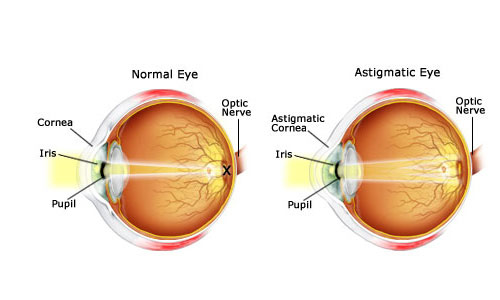
Astigmatism
The front surface of the eye called the “cornea” is dome-shaped like a sphere. In Astigmatism, the surface of the eye is not perfectly spherical, but instead is warped or uneven. Normally, the cornea and lens are smooth and curved equally in all directions, helping to focus light rays sharply onto the retina at the back of your eye. However, if your cornea or lens isn’t smooth or evenly curved, light rays aren’t refracted properly. You may not notice small amounts of astigmatism at all or have just slightly blurred vision. With uncorrected astigmatism, you may have headaches or eye strain and distort at all distances. Regular astigmatism can be corrected with glasses or contact lenses because it is often associated with myopia (nearsightedness) or hyperopia (farsightedness).
Learn More

Lazy Eye
Amblyopia or “lazy eye” is poor vision in an eye that did not develop normal sight during early childhood. This is a very common condition, approximately two or three out of every 100 people has amblyopia. During the first 8-10 years of life, the visual system is developing. If amblyopia is discovered within the first 8 or so years of life, vision can often be recovered. The best time to correct amblyopia is during infancy or early childhood. If the eye is not able to send clear pictures to the brain during these early stages of life, the visual system may never fully develop. Any of our eye doctors can teach you how amblyopia can be treated, and can help you and your child successfully carry out this treatment.
Learn More
